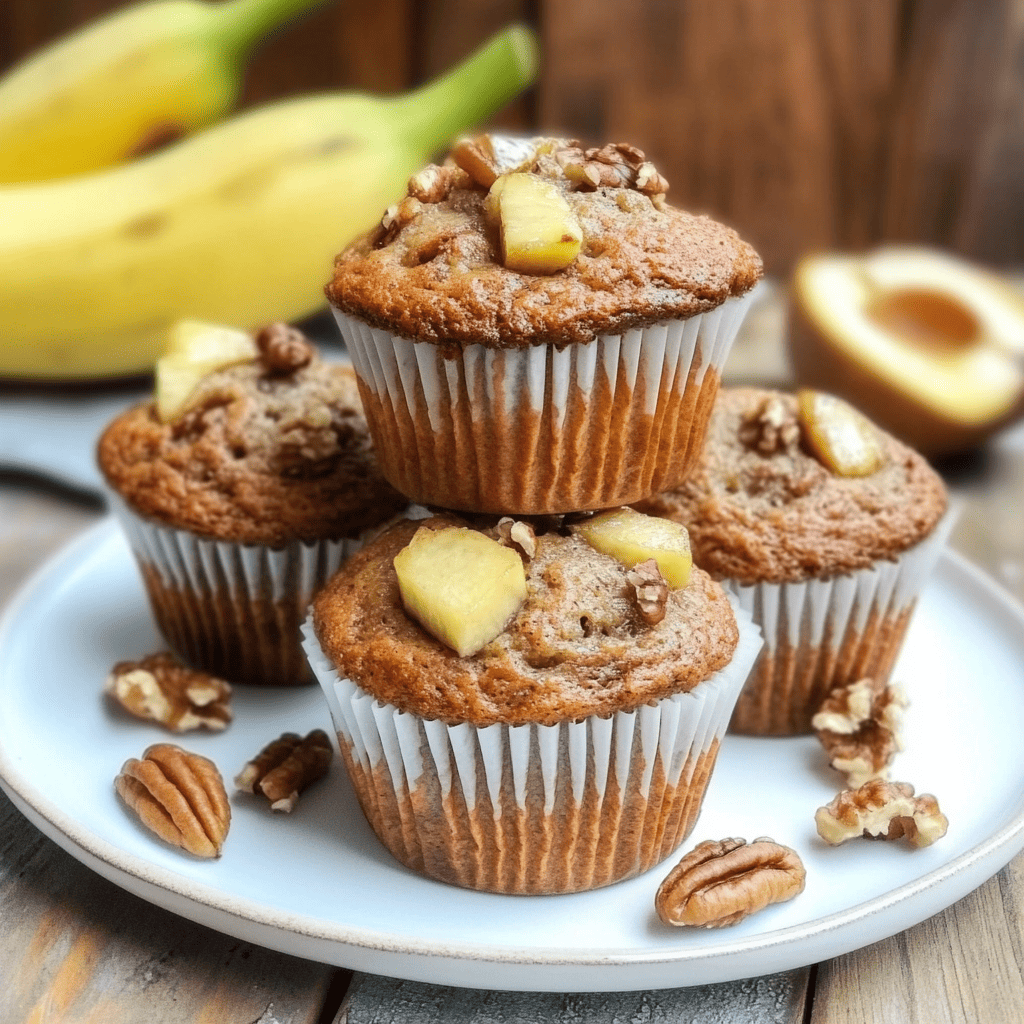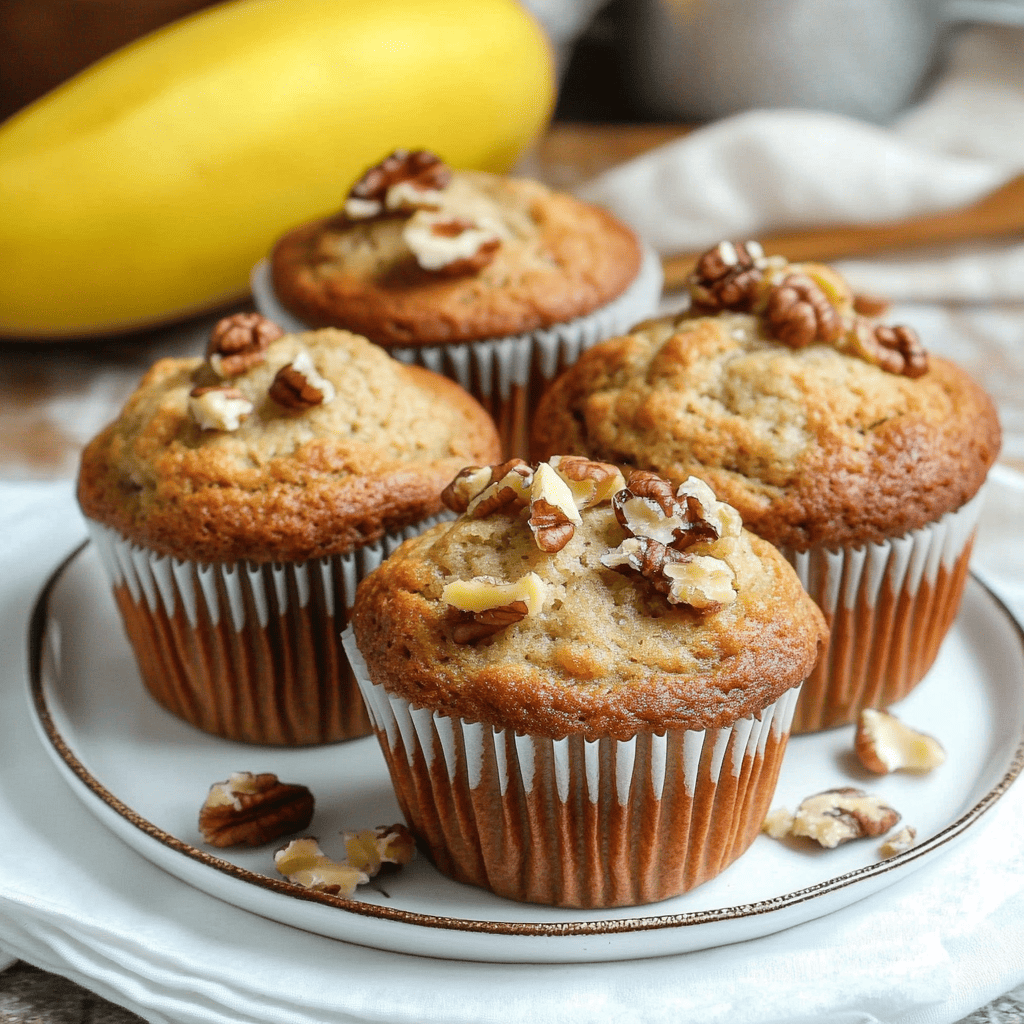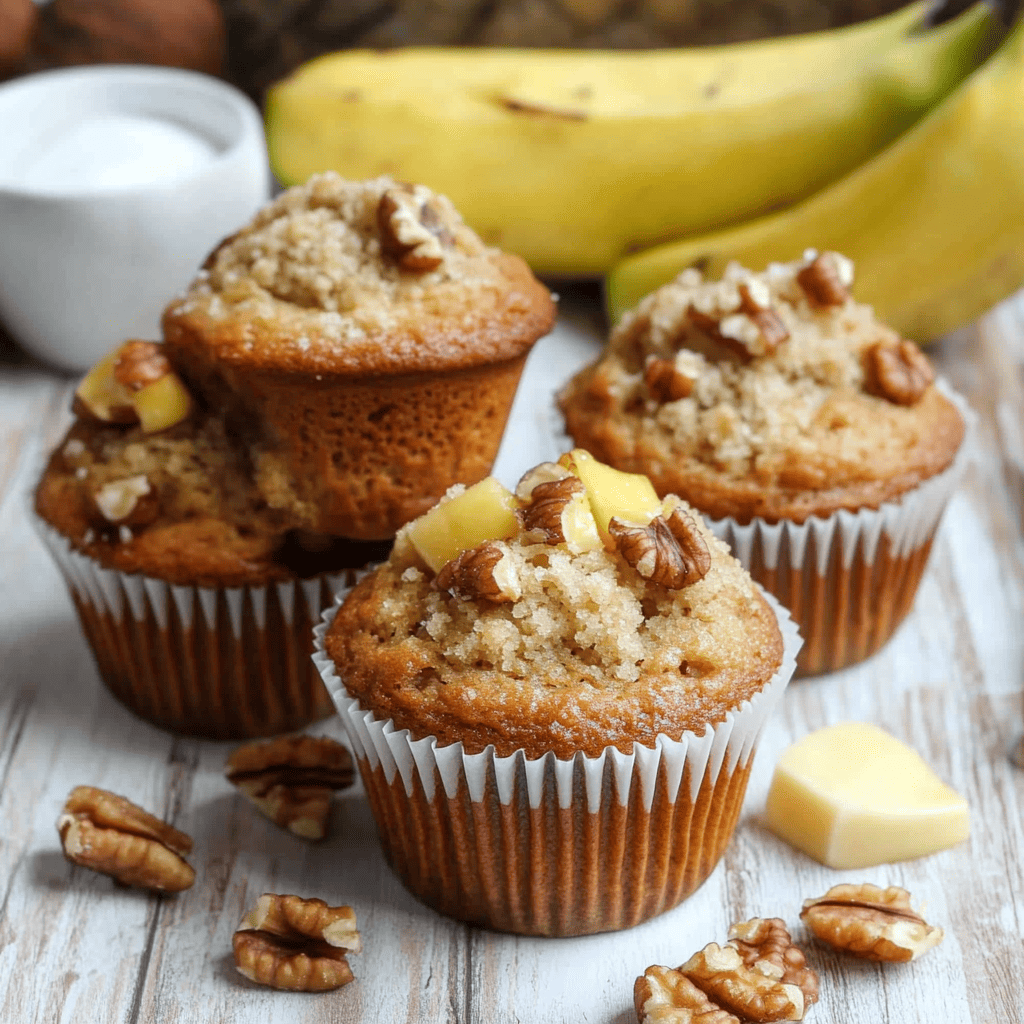Banana Walnut Muffins
Banana walnut muffins are a classic treat that combines the softness and natural sweetness of ripe bananas with the crunch of walnuts. They’re ideal for breakfast, afternoon snacks, or as a healthy snack. Plus, they’re easy to prepare and don’t require any specialized equipment.
History and Origin of Banana Walnut Muffins
The muffin is an individual bread roll of English and American origin , whose popularity has grown worldwide due to its practicality and versatility.
The combination of banana and nuts in muffins originates in North American baking, where bananas began to be widely used in cooking in the early 20th century. Before this period, bananas were not common in bakeries, but with the development of preservation and transportation techniques, they became a staple ingredient in many homes.
The use of ripe banana in baking has two main purposes:
- Take advantage of ripe bananas that would otherwise go to waste.
- Provide natural sweetness and moisture to the dough without adding large amounts of sugar or fat.
Walnuts , on the other hand, have been used in baking for centuries due to their flavor, texture, and nutritional value. In the United States, pecans and walnuts are popular ingredients in baking recipes, which led to the perfect combination with bananas in muffins and quick breads.
With the rise of quick breads in the 20th century, banana and walnut muffins became a common choice in cafes and homes. Today, this recipe remains a favorite for its fluffy texture, comforting flavor, and nutritional benefits.
Banana walnut muffins have an interesting history that dates back to the evolution of baking and the use of natural ingredients in cooking. This recipe is a variation on the famous banana bread , which became popular in the United States in the 20th century.
Origin of Muffins and Banana Bread
Influence of English and American Muffins
Muffins have two different origins:
- English muffins (10th-12th century) were flatbreads baked in a pan, similar to today’s English muffins.
- American muffins (18th-19th century) emerged with the arrival of baking powder, which made small loaves fluffier and easier to bake in individual pans.
Banana muffins were born from the tradition of American muffins, as they are a variation on quick breads, which use baking powder instead of yeast to make them easier to prepare.
Banana in Baking
Before the 20th century, plantains were not a common ingredient in Western cuisine. However, with the expansion of international trade and the arrival of plantains from Central America and the Caribbean, they became more accessible and began to be used in various recipes.
The problem was that ripe bananas spoiled quickly. It was in the 1930s, during the Great Depression , that housewives began looking for ways to use up overripe bananas, as they couldn’t afford to waste them. This is how recipes like banana bread , the precursor to banana nut muffins, emerged.
The Rise of Banana Bread and the Transformation into Muffins
Banana bread became popular in the 1930s thanks to the publication of recipes in cookbooks and the widespread availability of chemical leaveners such as baking soda and baking powder.
Over time, the recipe evolved, and in the second half of the 20th century, individual versions began to be made in muffin tins . This made the recipe even more practical, as the muffins:
Bake faster than a whole loaf.
Are easy to transport and store.
Can be customized with different toppings (nuts, chocolate, oats, etc.).
Walnuts began to be incorporated into recipes for their flavor and crunch, in addition to their nutritional benefits. In the United States , pecans and walnuts were popular baking ingredients, which led to their inclusion in banana muffins.
Popularity Today
Today, banana and walnut muffins are one of the most beloved recipes in both home and commercial baking. They can be found in bakeries, cafes, and supermarkets around the world. They have also evolved into healthier, gluten-free versions or with additional ingredients like chocolate chips or cinnamon.
Thanks to their balance of natural sweetness, smoothness, and a touch of crunch, they remain an ideal choice for breakfast, a snack, or a nutritious dessert.

Ingredients (for 12 muffins)
Dry ingredients
- 1 1/2 cups (180 g) all-purpose flour
- 1 teaspoon of baking soda
- 1 teaspoon baking powder
- ½ teaspoon of salt
Wet ingredients
- 3 ripe bananas (mashed)
- ¾ cup (150 g) granulated sugar
- ⅓ cup (80 ml) vegetable oil or melted butter
- 1 large egg, beaten
- 1 teaspoon vanilla extract
Extra addition
- ½ cup (60 g) chopped walnuts (walnuts or pecans)
Step-by-Step Instructions
Initial Preparation
- Preheat oven to 190°C (375°F) .
- Grease or place paper liners in a muffin pan.
Mix the Dry Ingredients
- In a medium bowl, mix the flour, baking soda, baking powder and salt .
- Set aside this mixture.
Mix the Wet Ingredients
- In a large bowl, combine the mashed bananas, sugar, vegetable oil (or melted butter), beaten egg, and vanilla .
- Mix well until a homogeneous mixture is obtained.
Integrate the Mixture
- Gradually add the dry ingredients to the wet mixture.
- Stir with a spatula or hand mixer until the ingredients are combined. Do not overmix to avoid dense muffins.
- Add the chopped walnuts , mixing gently.
Baked
- Pour the mixture into the muffin tin, filling each tin ⅔ full .
- Bake for 18-20 minutes , or until a toothpick inserted in the center comes out clean .
- Remove from the oven and let rest in the pan for 5 minutes before transferring to a wire rack to cool completely.
Tips and Variations
For a healthier twist : Some of the sugar can be substituted with honey or brown sugar for a deeper flavor. Whole wheat flour can also be used instead of white flour.
For a juicier texture : Add 1/4 cup of plain yogurt or sour cream to the mix.
Gluten-free option : Use almond flour or a gluten-free flour blend in the same proportion.
For an extra kick : Add cinnamon or nutmeg to the mix for a spicier aroma.
Chocolate version : Dark chocolate chips can be added for a more indulgent version.

Nutritional Properties of Banana and Walnut Muffins
Banana and walnut muffins are not only delicious, but they also provide various nutritional benefits thanks to their main ingredients:
- Banana
- Rich in potassium , which helps regulate blood pressure.
- Contains dietary fiber , promoting digestion.
- Source of vitamin B6 , essential for metabolism and brain function.
- Its natural sweetness allows to reduce the amount of added sugar.
- Walnuts
- They provide healthy fats such as Omega-3 fatty acids.
- They provide vegetable protein , helping to maintain satiety.
- They contain antioxidants and vitamin E , which protect the body’s cells.
- They promote heart health by reducing bad cholesterol (LDL).
- Wheat Flour
- Source of complex carbohydrates , providing sustained energy.
- It provides small amounts of protein and minerals such as iron.
- Eggs
- Excellent source of high quality protein .
- They contain choline , a key nutrient for brain health.
- Vegetable Oil or Butter
- They provide fats necessary for the absorption of fat-soluble vitamins.
- Butter gives a richer flavor, while vegetable oil maintains a moister texture.
Curiosities and Interesting Facts
Did you know that banana bread and banana muffins became popular during the Great Depression?
During the economic crisis of the 1930s in the United States, many families looked for ways to make the most of ingredients. Ripe bananas, which were often thrown away, became a key ingredient in creating economical and nutritious recipes, giving rise to the famous banana bread and its muffin versions.
Banana as an Egg Substitute
If you want to make vegan muffins, you can replace the egg with ½ an additional ripe banana or ¼ cup of applesauce . This will add moisture and structure to the batter.
Why you shouldn’t overmix your batter:
When you overmix flour with wet ingredients, excess gluten develops , resulting in dense, tough muffins. It’s best to stir gently and only until the ingredients are combined .
How to make fluffier muffins?
- Use fresh baking powder and sift the flour to aerate it.
- Make sure to preheat your oven thoroughly before baking.
- Fill the molds only ⅔ full so they have room to grow without overflowing.
Conservation and Storage
At room temperature :
Store in an airtight container for up to 3 days .
In the refrigerator :
If you want them to last longer, store them in a sealed container and consume them within 5-7 days .
Freezing :
You can freeze them in an airtight bag for up to 3 months . To eat, simply heat them in the oven or microwave.
What Drinks Go Well With These Muffins?
Banana Walnut Muffins are best enjoyed with:
- Coffee or espresso for a comforting breakfast.
- Cinnamon or ginger tea to enhance its flavors.
- Almond or oat milk for a light and healthy option.
- Hot chocolate for an indulgent snack.
Reflection Questions
- History and Origin
- What is the origin of muffins and how did they evolve to include banana and walnut?
- Why were bananas not a common ingredient in baking before the 20th century?
- How did the Great Depression influence the popularization of banana bread and its muffin versions?
- Ingredients and Benefits
- What nutritional properties do bananas and walnuts contribute to this recipe?
- How can this recipe be made healthier without losing its flavor and texture?
- What role does baking soda play in the final texture of muffins?
- Preparation Techniques
- Why shouldn’t you overmix the dough when adding the dry ingredients?
- How can you make muffins fluffier and airier?
- What is the best way to store muffins so they stay fresh longer?
- Adaptations and Variations
- What other ingredients can be added to banana and walnut muffins to give them a different touch?
- How can muffins be adapted for people with dietary restrictions, such as gluten-free or vegan diets?
- How does the choice between butter and vegetable oil affect the flavor and texture of muffins?
Texture and Flavor
- Texture:
Soft, moist, and airy in the center, with a touch of crunch from the chopped walnuts. The ripe banana provides natural moisture and fluffiness. - Flavor:
Naturally sweet from the banana, with toasted and earthy notes from the walnut, and a light touch of vanilla. Ideal for those looking for a comforting, homemade flavor.
Consumer Context
- Perfect for breakfast, brunch, snacks , or to accompany a cup of coffee or tea.
- Very common in homes, cafes and artisan bakeries .
- They are also prepared as a homemade pastry option to give as a gift or share at family gatherings .
Visual Aspect
- Golden on the outside with dark banana veins.
- The top tends to swell with a slight central crack (a symbol of good cooking).
- The visible nuts give it a rustic and appetizing appearance .
Curiosities
- Banana nut muffins originated as a single-serving variation on banana bread .
- It’s an ideal recipe to use up overripe bananas that wouldn’t be eaten on their own.
- They are popular in countries like the United States, Mexico, and many regions of Latin America.
Estimated Nutritional Value (per muffin)
- Calories: 190–220 kcal
- Fat: 9–12 g (depending on whether butter or oil is used)
- Carbohydrates: 26–30 g
- Sugars: 12–16 g (natural from banana + added sugar)
- Protein: 3–4 g
- Fiber: Approx. 2 g.
(Approximate values, may vary depending on muffin size and specific ingredients used.)
Additional Benefits and Interesting Facts
- Ripe bananas : rich in potassium, vitamin B6 and antioxidants.
- Nuts : source of healthy fats, omega-3 and vegetable proteins.
- Easy to adapt : can be made with whole wheat flour, no refined sugar, or vegan substitutes.
- They are an excellent option for children due to their naturally sweet flavor and soft texture.
- They keep very well for several days and can also be frozen.

Conclusion
Banana and walnut muffins are a classic recipe that has endured over time due to their perfect combination of flavor, texture, and nutritional value. Their history shows us how baking has evolved from the need to utilize ingredients and adapt to available resources.
The arrival of the banana in Western cuisine and its incorporation into baking was a significant change that led to the creation of the famous banana bread and its muffin versions. Throughout the 20th century, the recipe transformed into a more practical and versatile option, allowing for the addition of ingredients such as nuts, chocolate, spices, and alternative flours.
From a nutritional standpoint, banana and walnut muffins stand out for their balance of carbohydrates, fiber, healthy fats, and protein , making them an ideal choice for an energetic breakfast or a nutritious snack. They’re also easy to prepare and can be easily adapted to different dietary needs.
In terms of preparation technique , the key to fluffy and delicious muffins is:
Don’t overmix the batter , to avoid a dense texture.
Use ripe bananas , which provide natural sweetness and moisture.
Properly incorporate the baking powder and baking soda to ensure a good rise in the oven.
Thanks to their versatility and ease of preparation, these muffins have transcended generations and remain a favorite recipe in both home and commercial kitchens.
Banana and walnut muffins are a classic recipe that has endured over time thanks to their perfect combination of natural sweetness, softness, and crunch. They’re ideal for breakfast, snacks, and desserts, and are a great way to use up ripe bananas that would otherwise go to waste.
Their versatility allows for adaptations to different dietary preferences and needs, from healthier versions to chocolate- or spice-based variations. Their ease of preparation makes them perfect for both beginners and experienced cooks.

